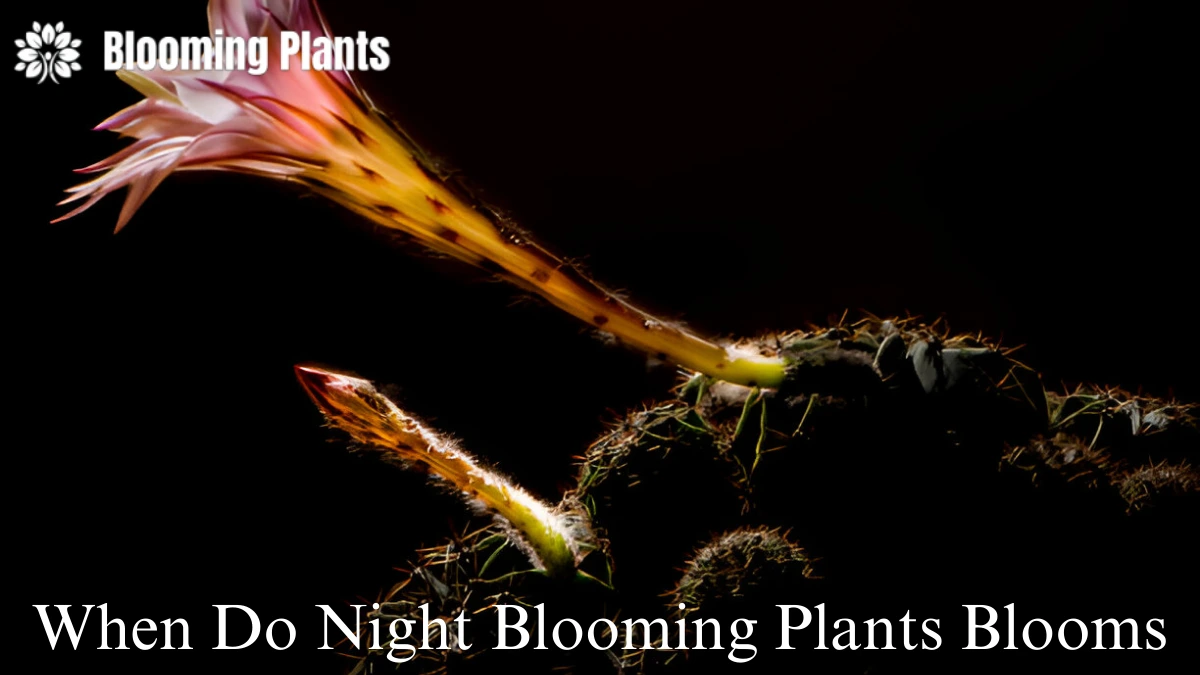1. Introduction to Night Blooming Plants
What Are Night Blooming Plants?
When Do Night Blooming Plants Bloom? Night-blooming plants, or nocturnal plants, are a unique group of flora that bloom exclusively after sunset. These plants have evolved to attract nighttime pollinators like moths, bats, and certain beetles, ensuring their reproduction without sunlight.
The Magic of Nighttime Blooms
From their intoxicating fragrances to their ethereal beauty, night blooming plants create a magical ambiance in gardens. They offer a sensory experience that is both calming and captivating, making them a favorite among evening gardeners.
Why Do They Bloom at Night?
Night blooming plants have adapted to bloom in low-light conditions to reduce competition with daytime flowers for pollinators. This adaptation also helps them conserve energy and water, making them ideal for arid environments.
2. When Do Night Blooming Plants Bloom?
Evening Hours: The Start of the Show
Most night blooming plants begin to unfurl their flowers during the late evening hours, typically between 6 PM and 9 PM. This timing coincides with the emergence of nocturnal pollinators like moths and bats, ensuring maximum pollination efficiency.
Peak Blooming Periods
- Midnight Blossoms: Many plants reach their peak blooming stage around midnight, showcasing fully open flowers with heightened fragrance to attract pollinators.
- Seasonal Variations: While some plants bloom nightly, others are seasonal, flowering only during specific times of the year, such as summer or monsoon months.
Duration of Blooms of When Do Night Blooming Plants Bloom
- Short-Lived Blooms: Some plants, like the moonflower, bloom for just a single night before wilting.
- Extended Bloomers: Others, such as jasmine, continue to bloom over several nights, providing a prolonged display of beauty.
3. Types of Night Blooming Plants
Popular Night Blooming Species
- Moonflower (Ipomoea alba): Renowned for its large, white blossoms and sweet fragrance, the moonflower opens at dusk and closes by dawn.
- Night Blooming Jasmine (Cestrum nocturnum): This plant is famous for its intense, heady scent that fills the air during the evening.
- Queen of the Night (Epiphyllum oxypetalum): Often called “night-blooming cereus,” this cactus produces stunning, fragrant flowers that bloom for just one night.
Exotic Nocturnal Flowers
- Brahma Kamal (Saussurea obvallata): Native to the Himalayas, this rare flower is considered sacred and blooms only once a year.
- Evening Primrose (Oenothera): Known for its bright yellow flowers, this plant blooms at dusk and remains open until the following morning.
- Night Phlox (Zaluzianskya capensis): Also called “midnight candy,” this plant releases a sweet, candy-like fragrance after sunset.
4. Cultivating Night Blooming Plants in Your Garden
Choosing the Right Plants
- Climate Compatibility: Select species that thrive in your local climate and soil conditions.
- Space and Light Requirements: Ensure you have adequate space and consider partial-shade areas for planting.
Soil Preparation of When Do Night Blooming Plants Bloom
- Use well-draining soil enriched with organic matter to provide a nutrient-rich environment for your plants.
- Maintain slightly acidic to neutral soil pH levels for optimal growth.
Watering and Fertilization of When Do Night Blooming Plants Bloom
- Watering: Night blooming plants generally require consistent moisture but avoid overwatering to prevent root rot.
- Fertilization: Use a balanced fertilizer to support blooming and overall plant health.
5. Benefits of Growing Night Blooming Plants
Aesthetic Appeal
Night blooming plants add a unique charm to gardens, offering visual and olfactory delight during evening hours.
Ecological Importance of When Do Night Blooming Plants Bloom
These plants play a vital role in supporting nocturnal pollinators, contributing to biodiversity and ecosystem balance.
Therapeutic Effects of When Do Night Blooming Plants Bloom
The calming presence and soothing fragrances of night blooming plants promote relaxation, making them ideal for evening meditation or leisure.
6. Designing a Night Garden
Plant Selection of When Do Night Blooming Plants Bloom
- Combine various night blooming plants to create a layered, dynamic garden design.
- Include plants with different bloom durations for a continuous display of flowers.
Lighting of When Do Night Blooming Plants Bloom
- Use soft, ambient lighting to highlight the blooms and create a serene atmosphere.
- Avoid harsh lights that may disrupt the natural blooming cycles of the plants.
Pathways and Seating
- Incorporate pathways and cozy seating areas to encourage evening strolls and relaxation.
- Add decorative elements like lanterns or water features to enhance the nighttime experience.
7. Common Challenges with Night Blooming Plants
Pest Management of When Do Night Blooming Plants Bloom
Night blooming plants can attract pests like aphids and caterpillars. Regular inspection and organic treatments can help mitigate infestations.
Climate Sensitivity of When Do Night Blooming Plants Bloom
Some species may be sensitive to extreme temperatures or humidity levels. Provide adequate protection during adverse weather conditions.
Limited Lifespan of Blooms
The short-lived nature of many night blooming flowers can be disappointing. Planting a variety of species ensures a continuous display.
Conclusion: Embrace the Mystery of Night Blooming Plants
Night blooming plants bring an enchanting element to any garden. Their unique blooming patterns, captivating fragrances, and ecological significance make them a worthwhile addition to your outdoor space. By understanding their blooming times and cultivating them with care, you can create a magical nighttime oasis that thrives under the moonlight.
FAQs
- What are some common night blooming plants? Popular options include moonflowers, night blooming jasmine, and Queen of the Night.
- Why do some plants bloom only at night? Night blooming plants have adapted to attract nocturnal pollinators and conserve energy.
- How can I care for night blooming plants? Provide well-draining soil, consistent watering, and adequate light and shade.
- Can night blooming plants thrive in pots? Yes, many species like night blooming jasmine and moonflowers grow well in containers.
- What is the best time to plant night blooming species? Plant them during the growing season, ensuring they have enough time to establish before blooming.

